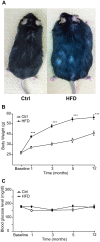A high-fat diet delays age-related hearing loss progression in C57BL/6J mice
- PMID: 25625852
- PMCID: PMC4308197
- DOI: 10.1371/journal.pone.0117547
A high-fat diet delays age-related hearing loss progression in C57BL/6J mice
Abstract
Objective: Age-related hearing loss (AHL), or presbycusis, is the most common sensory disorder among the elderly. We used C57BL/6J mice as an AHL model to determine a possible association between AHL and a high-fat diet (HFD).
Methods: Forty C57BL/6J mice were randomly assigned to a control or HFD group. Each group was divided into the following subgroups: 1-, 3-, 5- and 12-month groups (HFD, n = 5/subgroup; control, n = 5/subgroup). Nine CBA/N-slc mice were also used as a 12-month control (n = 5) or 12-month HFD (n = 4) group. The mice were fed a HFD or normal (control) diet throughout this study. Hearing function was evaluated at 1, 3, 5 and 12 months using auditory evoked brainstem responses (ABRs). Spiral ganglion cells (SGCs) were also counted.
Results: The elevation of ABR thresholds (at 4 and 32 kHz) at 3 and 5 months was significantly suppressed in the HFD group compared with the control groups for C57BL/6J mice. After 12 months, the elevation of ABR thresholds was significantly suppressed in the HFD group at all frequencies for C57BL/6J mice. In contrast, CBA/N-slc mice displayed opposite outcomes, as ABR thresholds at all frequencies at 12 months were significantly elevated in the HFD group compared with the control group. For the C57BL/6J mice at 12 months, SGC numbers significantly decreased in all parts of the cochleae in the control group compared with the HFD groups. In contrast, for the CBA/N-slc mice, SGC numbers significantly decreased, particularly in the upper parts of the cochleae in the HFD group compared with the control groups.
Conclusions: The elevation in ABR thresholds and SGC loss associated with aging in the HFD-fed C57BL/6J mice were significantly suppressed compared with those in the normal diet-fed mice. These results suggest that HFD delays AHL progression in the C57B/6J mice.
Conflict of interest statement
Figures



References
-
- Gates GA, Mills JH (2005) Seminar Presbycusis: 1111–1120. - PubMed
-
- Gates GA, Cobb JL, D’Agostino RB, Wolf PA (1993) The relation of hearing in the elderly to the presence of cardiovascular disease and cardiovascular risk factors. Arch Otolaryngol Head Neck Surg 119: 156–161. - PubMed
-
- Suzuki K, Kaneko M, Murai K (2000) Influence of serum lipids on auditory function. Laryngoscope 110: 1736–1738. - PubMed
Publication types
MeSH terms
LinkOut - more resources
Full Text Sources
Other Literature Sources
Molecular Biology Databases

